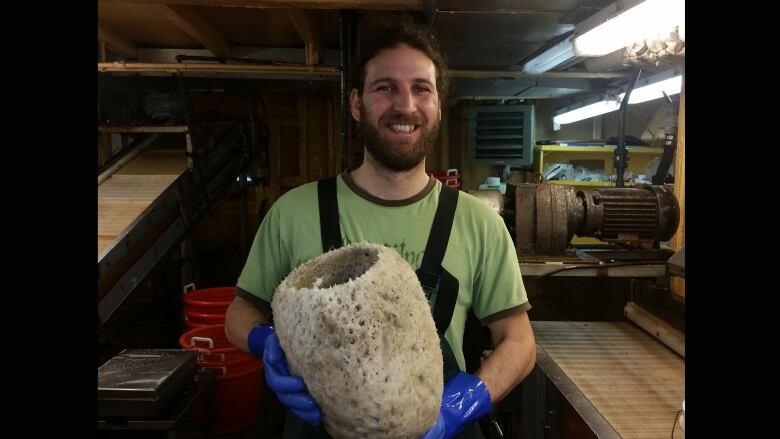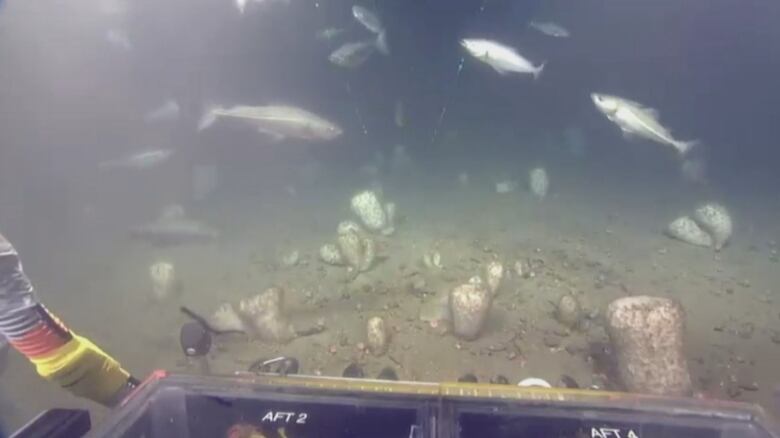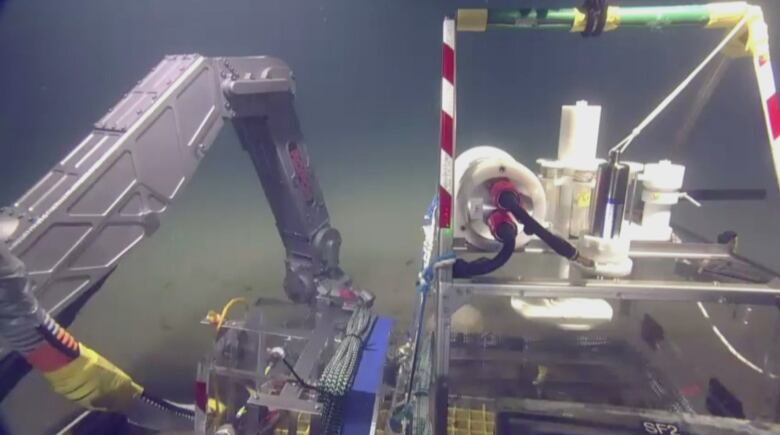Underwater technology makes ocean floor a laboratory for deep sea sponges
Robotic arms allow precise movements required for scientific measurements

Advanced Canadian technology is allowing scientists off Nova Scotia to carry out tests on the ocean floor that once had to be done inside the laboratory.
Agile robotic arms controlled from a Canadian Coast Guard vessel 120 metres above are plucking delicate sponges made of glassfrom the ocean floor and placing them inside a special chamber where respiration is being measured.
"It's never been done. These are new chambers specifically designed for this project," saidEllen Kenchington, a benthic ecologist with Canada's Department of Fisheries and Oceans.
"These sponges are globally unique,so on this particular species, this is all new information."

Joint research project
The joint, four-year Canadian and European research project is trying to understand the roleplayed in the ecosystem by the sea sponges, which live in 259 square kilometres of protected sponge grounds on the Emerald Bank and Sambro Bankon the Scotian Shelf.
Live images sent back by the expedition and posted on DFO's Deep-Sea SpongesFacebook page show a soft sediment ocean floor festooned with the white, cotton candy-like sponges.
Pollock are constantly swimming through the pictures.
Russian Hats
Laboratory tests last year at the Bedford Institute of Oceanography showed the silica sponges, dubbed Russian Hats because that is what they resemble,strip 95 per cent of all particulate matter out of the water they ingest.
The sponges filter everything from plankton to bacteria.
For the first time this week, those measurements are being made on the ocean floor.

"We are measuring the water before they are in the chamber and after they have been in there for a period of time," saidKenchington.
Kenchington saidresearch off Norway showed a one-kilogram sponge can filter 25,000 litres of water a day.
"We're going to take those figures and apply it to the density of sponges we are seeing and get some upscaleto some larger figure so we can talk about just what is it these sponge grounds are doing," she says.
Agile robotic arms
The Victoria, B.C.-based non-profit company ROPOS is providing the technicians and remotely operated vehicle that is making the underwater measurements possible.
A key feature on the ROV istwo state-of-the-art hydraulic arms capable of extremely precise movement.

ROPOS supervisor Vincent Auger saidthe "seven function manipulators" are operated by a technician on board the vessel.
"We are able to control the arm to the point where you could write your name on a piece of paper with it," Auger said.
'This is what we live for'
The movements are considerably slower since the operator is guided by several cameras.
Auger saidthe sponge researchers are constantly pushing the limits of the technology, asking ROPOS to replicate with robot arms what divers do in shallower waters like placing tiny sensors in a sponge mouth twoto threecentimetres wide.

"This us is what we live for," Auger said. "Every time we got out with scientists, they are so passionate, it's contagious. We always try to make their projects successful."
ROV costs $25,000 a day
None of this is cheap.
Kenchington says the remotely operated vehicle costs about $25,000 a day at sea, with ship time between $30,000 and$40,000 a day.
The European Union is paying forthe remotely operated vehicle,spending $14 million on the sponge project.
Scientists from Norway, Netherlands, Spain and United Kingdom are on board the CCGS Martha Black.
The Canadian Coast Guard buoy tender was pressed into service because Canada's primary research vessel, the Hudson, is unavailable because of a delayed refit.
The expedition will return to Halifaxon Thursday.












_(720p).jpg)


 OFFICIAL HD MUSIC VIDEO.jpg)
.jpg)



























































































